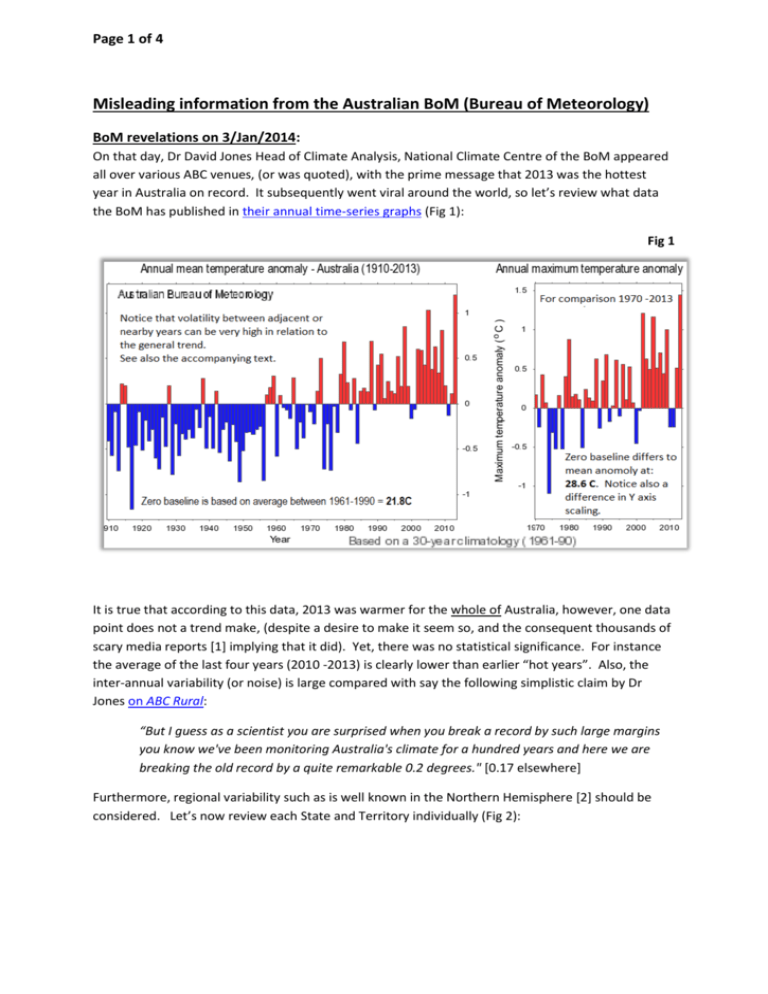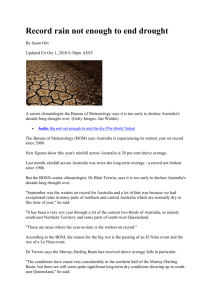Misleading information from the Australian BoM (Bureau of
advertisement

Page 1 of 4 Misleading information from the Australian BoM (Bureau of Meteorology) BoM revelations on 3/Jan/2014: On that day, Dr David Jones Head of Climate Analysis, National Climate Centre of the BoM appeared all over various ABC venues, (or was quoted), with the prime message that 2013 was the hottest year in Australia on record. It subsequently went viral around the world, so let’s review what data the BoM has published in their annual time-series graphs (Fig 1): Fig 1 It is true that according to this data, 2013 was warmer for the whole of Australia, however, one data point does not a trend make, (despite a desire to make it seem so, and the consequent thousands of scary media reports [1] implying that it did). Yet, there was no statistical significance. For instance the average of the last four years (2010 -2013) is clearly lower than earlier “hot years”. Also, the inter-annual variability (or noise) is large compared with say the following simplistic claim by Dr Jones on ABC Rural: “But I guess as a scientist you are surprised when you break a record by such large margins you know we've been monitoring Australia's climate for a hundred years and here we are breaking the old record by a quite remarkable 0.2 degrees." [0.17 elsewhere] Furthermore, regional variability such as is well known in the Northern Hemisphere [2] should be considered. Let’s now review each State and Territory individually (Fig 2): According to this BoM data, four of the seven regions were cooler in 2013 and only one (South Australia) was significantly warmer, (although again, the SA four-year 2010 to 2013 average was much cooler). Thus, the following claims by Dr Jones on ABC’s AM gave misleading perspectives (sometimes known as cherry picking): “So 2013 was by far Australia's hottest year on record.” “We know last year for example, every single case that we've recorded temperatures was above average. We know every place across Australia is getting hotter, and very similarly almost every place on this planet”. In fact, the BOM records show that only South Australia was significantly warmer in 2013, despite the values shown in Fig 1. It would seem that this ambiguity of data arises from the major “noise” referred to under Fig 1 being in random annual and regional distribution. Thus, usually whilst there may be a big high in one region at a particular time, in others it can be simultaneously low, such that their average is depressed. Study of the time-series in Fig 2 reveals that the significant high in South Australia atypically coincided with modest highs in all the other six regions in 2013 such that their combined average was a fluky high number without any significance trend-wise. A disturbing aspect of this is that statistical matters are a part of the work performed by the BoM (and similar agencies) and yet a relevant BoM senior representative (Dr Jones) eagerly misled the public on the statistical significance! Another important consideration is the seasonal distribution. For instance, warmer winters are arguably a good thing and hotter summers generally no. So let’s see what happened seasonally for the standout hottest State: So here we go again; for the whole of 2013 South Australia was the biggest record breaker at over half a degree hotter, and yet for each and every one of its four seasons, all were cooler than in random earlier years. Again, this is apparently a coincidence of fluky all positive alignments in 2013, normally randomly opposed, as discussed under Fig 2. First cab off the rank for Dr Jones seems to have been on ABC Breakfast (audio here) with Fran Kelly wherein he did say (my transcript): “The Year [2013] started with an exceptionally hot January, the hottest month on record at least since 1910” I quickly describe what can be graphically found here (by clicking the drop-down menus). According to the BOM time-series, mean January highs have been arguably flat since 1934 for NT, and 1947 for Queensland. NSW + ACT show hotter Januarys going back to 1938. South Australia, hottest region for the whole year, (per Fig 2), has eight hotter Januarys going back to 1933. Tasmania has about twenty-five hotter Januarys going back to 1917. Victoria has about twenty hotter Januarys going back to 1939. For WA, there was a January of similar hotness in 1932, and two rather more recently which were considerably hotter. So here is the graphic for South Australia, the hottest State in 2013, updated to January 2014 and for comparison for the whole of Australia: Fig 4 Also, using the link immediately above, and its drop-down menu the surrounding four months of January 2013 (Nov –March) were remarkably cooler, and a hot January alone does not a hot summer make Dr Jones went on to say: “We had the hottest summer on record” Here follows the summer record for the whole of Australia, which is rather interesting: Fig 5 It is interesting to see that the very high inter-annual volatility (noise) is greater than for the whole year (See Fig 1…. and summer is arguably the most important season in the event of a significantly increasing temperature trend). Just to demonstrate that treating 2013 as statistically significant is wrong, let us re-examine some relevant words of wisdom from Dr Jones: “But I guess as a scientist you are [I am] surprised when you break a record by such large margins you know we've been monitoring Australia's climate for a hundred years and here we are breaking the old [annual] record by a quite remarkable 0.2 degrees." [0.17 elsewhere] If 0.17 C is a remarkable increase over a past record, what would he say if transported back some forty years when the previous record of 1938 was apparently smashed by about double that amount? Well anyway, State by State, all of them have had considerably hotter summers than in 2013! You can check this out here by using the drop-down menu. FOOTNOTES: [1] In an advanced Google-au search 3/Feb for all of words and phrase: 2013 australia “hottest year” restricted to the past month there were about 7,600 hits globally. This picks-up the start of the affair on 3/Jan. (Screen shot is available) [2] Here is a NOAA map of recent great regional variability in the USA Page 4 of 4








